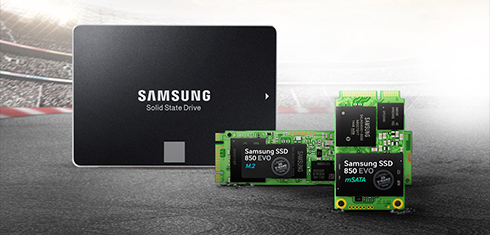Life moves pretty fast when Moore’s Law is driving things. Computing power has increased exponentially over the past several decades, helping to deliver increased productivity and efficiencies in the workplace. Alongside the regular boosts in processing power we’ve witnessed, advances in memory and storage technologies have made it possible to harness that horsepower to create slim, light, blazing-fast mobile devices, PCs, and servers.
The good news for partners is that business customers who require the most efficient, highest-capacity solid state drives (SSDs) available today can count on Samsung to deliver.
Samsung’s cutting-edge, 48-layer V-NAND flash memory is a case in point. Remember that it wasn’t so long ago that flash memory was very expensive and not terribly economical to use in larger computers as a primary, long-term storage medium. Instead, PCs used small RAM sticks for temporary data storage and mechanical hard-disk drives (HDDs) for long-term information storage.
Up until just a few years ago, SSDs using flash memory were far more expensive than larger-capacity HDDs. Yet even then, the performance benefits of SSDs, such as faster read/write times, quieter operation, and better durability, meant that it still made a lot of sense to use them in certain PC and server configurations, or in hybrid configurations where the SSD served as the boot-up drive and the HDD held the large data files.
But while mechanical disk-drive technology has achieved only incremental improvements in recent years, SSDs and the flash memory on which they’re based have become faster, cheaper, more efficient, and able to squeeze more storage capacity into the same footprint.
Businesses have taken notice. With the advent of the new vertical-stacking flash technology called V-NAND, SSDs are approaching HDDs in terms of both capacity and pricing. In fact, Gartner and investment firm Stifel have projected that SSD revenue generated from enterprise sales is set to surpass HDD revenue in 2017, per The Register.
Samsung’s 48L V-NAND is hitting markets this year in SSDs like the updated 850 EVO series, which serves up a whopping 4TB of storage capacity.These drives utilize the next generation of what’s called “3D” NAND flash, which is created by stacking layers of information-storing flash cells on top of each other – a major advance over the older, two-dimensional planar memory architecture.
The upshot is that the latest 850 EVO SSDs from Samsung deliver double the chip capacity and a 30 percent reduction in power consumption with no performance drop-off from the previous generation of 32L V-NAND devices (540MB/s read, 520MB/s write; up to 98K/90K read/write IOPS). Keep in mind that Samsung’s very first generation of V-NAND drives released in 2013 had already jacked up performance by 20 percent over 2D planar flash memory, while reducing power consumption by 40 percent.
Not every business needs 850 EVO SSDs installed in its laptops. In fact, there are still plenty of instances where less costly SSDs using planar NAND, such as that used in the Samsung 750 EVO series, or HDDs are a better fit for a typical business user’s computing requirements. But for Samsung partners serving customers in compute-intensive fields like graphic design, architecture, drafting, and other industries, it’s nice to have the ability to offer the most advanced SSD for client computing on the market today.
Learn more about Samsung SSD products here .







